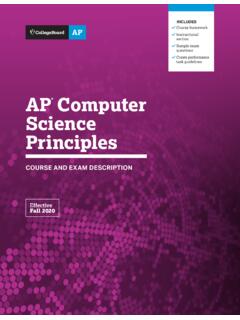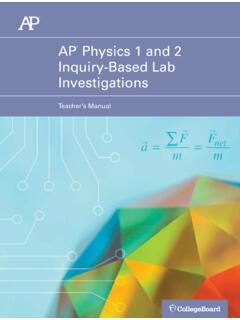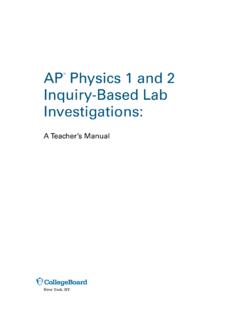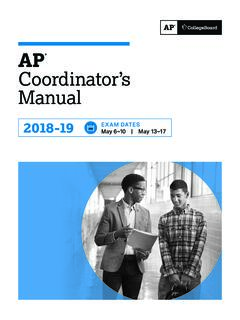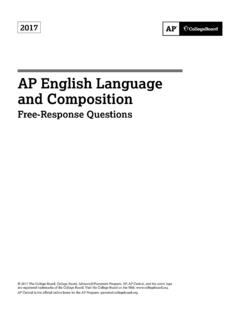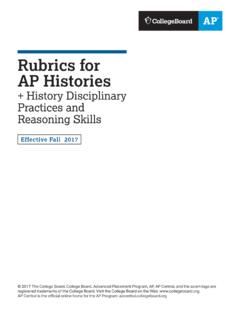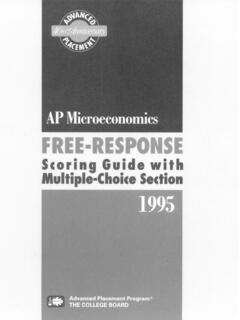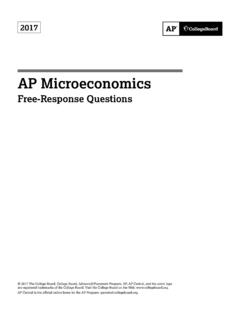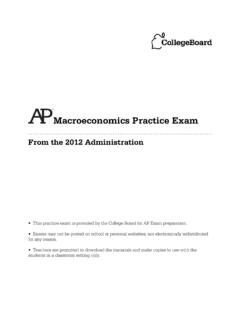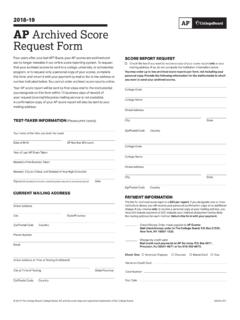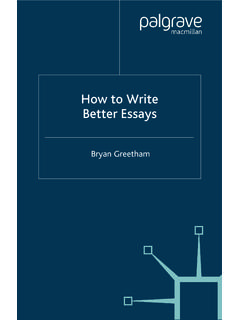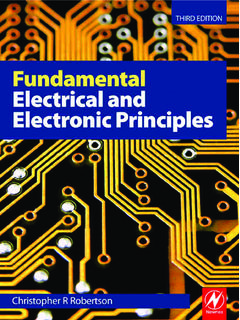Transcription of AP Chemistry Course and Exam Description, Effective Fall 2020
1 INCLUDES Course framework Instructional section Sample exam questionsAP ChemistryCOURSE AND EXAM DESCRIPTIONE ffective Fall 2020AP Course AND EXAM DESCRIPTIONS ARE UPDATED PERIODICALLYP lease visit AP Central ( ) to determine whether a more recent Course and exam description is ChemistryCOURSE AND EXAM DESCRIPTIONE ffective Fall 2020 About College BoardCollege Board is a mission-driven not-for-profit organization that connects students to college success and opportunity. Founded in 1900, College Board was created to expand access to higher education. Today, the membership association is made up of more than 6,000 of the world s leading educational institutions and is dedicated to promoting excellence and equity in education. Each year, College Board helps more than seven million students prepare for a successful transition to college through programs and services in college readiness and college success including the SAT and the Advanced Placement Program.
2 The organization also serves the education community through research and advocacy on behalf of students, educators, and further information, visit Equity and Access PolicyCollege Board strongly encourages educators to make equitable access a guiding principle for their AP programs by giving all willing and academically prepared students the opportunity to participate in AP. We encourage the elimination of barriers that restrict access to AP for students from ethnic, racial, and socioeconomic groups that have been traditionally underrepresented. Schools should make every effort to ensure their AP classes reflect the diversity of their student population. College Board also believes that all students should have access to academically challenging Course work before they enroll in AP classes, which can prepare them for AP success.
3 It is only through a commitment to equitable preparation and access that true equity and excellence can be : Sonny Mui and Bill Tully 2020 College Board. College Board, Advanced Placement, AP, AP Central, and the acorn logo are registered trademarks of College Board. All other products and services may be trademarks of their respective College Board on the web: v Acknowledgments 1 About AP 4 AP Resources and Supports 6 Instructional Model 7 About the AP Chemistry Course 7 College Course Equivalent 7 Prerequisites 7 Lab Requirement Course FRAMEWORK 11 Introduction 12 Course Framework Components 13 Science Practices 17 Course Content 22 Course at a Glance 27 Unit Guides 28 Using the Unit Guides 31 UNIT 1: Atomic Structure and Properties 45 UNIT 2: Molecular and Ionic Compound Structure and Properties 59 UNIT 3: Intermolecular Forces and Properties 81 UNIT 4: Chemical Reactions 97 UNIT 5.
4 Kinetics 115 UNIT 6: Thermodynamics 131 UNIT 7: Equilibrium 153 UNIT 8: Acids and Bases 171 UNIT 9: Applications of Thermodynamics LABORATORY INVESTIGATIONS 191 Lab Experiments 194 How to Set Up a Lab Program INSTRUCTIONAL APPROACHES 199 Selecting and Using Course Materials 200 Guided Inquiry in AP Chemistry 201 Instructional Strategies 204 Developing the Science Practices EXAM INFORMATION 215 Exam Overview 219 Sample Exam QuestionsSCORING GUIDELINES 227 Question 1: Short-Answer 229 Question 2: Long-AnswerAPPENDIXES 235 Periodic Table of the Elements 237 Equations and ConstantsReturn to Table of Contents 2020 College BoardAcknowledgmentsCollege Board would like to acknowledge the following committee members, consultants, and reviewers for their assistance with and commitment to the development of this Course .
5 All individuals and their affiliations were current at the time of Bonvallet, The College of Wooster, Wooster, OHBrenda Brockland, Prairie Ridge High School, Crystal Lake, ILKristen Cacciatore, East Boston High School, Boston, MARenee Cole, University of Iowa, Iowa City, IAKevin Hendren, New Trier High School, Winnetka, ILRoger Kugel, University of Cincinnati, Cincinnati, OHPaul Price, Trinity Valley High School, Fort Worth, TXAlice Putti, Jenison High School, Jenison, MIDave Yaron, Carnegie Mellon University, Pittsburgh, PACollege Board StaffSara Hunter, Associate Director, AP Curricular PublicationsTrinna Johnson, Director, AP Chemistry Content DevelopmentClaire Lorenz, Senior Director, AP Instructional Design and PD Resource DevelopmentSerena Magrogan, Senior Director, AP Instructional Design and PD Resource DevelopmentSPECIAL THANKS John R.
6 WilliamsonAP Chemistry Course and Exam Description | vTHIS PAGE IS INTENTIONALLY LEFT APCollege Board s Advanced Placement Program (AP ) enables willing and academically prepared students to pursue college-level studies with the opportunity to earn college credit, advanced placement, or both while still in high school. Through AP courses in 38 subjects, each culminating in a challenging exam, students learn to think critically, construct solid arguments, and see many sides of an issue skills that prepare them for college and beyond. Taking AP courses demonstrates to college admission officers that students have sought the most challenging curriculum available to them, and research indicates that students who score a 3 or higher on an AP Exam typically experience greater academic success in college and are more likely to earn a college degree than non-AP students.
7 Each AP teacher s syllabus is evaluated and approved by faculty from some of the nation s leading colleges and universities, and AP Exams are developed and scored by college faculty and experienced AP teachers. Most four-year colleges and universities in the United States grant credit, advanced placement, or both on the basis of successful AP Exam scores more than 3,300 institutions worldwide annually receive AP scores. AP Course DevelopmentIn an ongoing effort to maintain alignment with best practices in college-level learning, AP courses and exams emphasize challenging, research-based curricula aligned with higher education expectations. Individual teachers are responsible for designing their own curriculum for AP courses, selecting appropriate college-level readings, assignments, and resources.
8 This Course and exam description presents the content and skills that are the focus of the corresponding college Course and that appear on the AP Exam. It also organizes the content and skills into a series of units that represent a sequence found in widely adopted college textbooks and that many AP teachers have told us they follow in order to focus their instruction. The intention of this publication is to respect teachers time and expertise by providing a roadmap that they can modify and adapt to their local priorities and preferences. Moreover, by organizing the AP Course content and skills into units, the AP Program is able to provide teachers and students with free formative assessments Personal Progress Checks that teachers can assign throughout the year to measure student progress as they acquire content knowledge and develop skills.
9 Enrolling Students: Equity and AccessCollege Board strongly encourages educators to make equitable access a guiding principle for their AP programs by giving all willing and academically prepared students the opportunity to participate in AP. We encourage the elimination of barriers that restrict access to AP for students from ethnic, racial, and socioeconomic groups that have been traditionally underserved. College Board also believes that all students should have access to academically challenging coursework before they enroll in AP classes, which can prepare them for AP success. It is only through a commitment to equitable preparation and access that true equity and excellence can be AP Courses: The AP Course AuditThe AP Program unequivocally supports the principle that each school implements its own curriculum that will enable students to develop the content understandings and skills described in the Course framework.
10 While the unit sequence represented in this publication is optional, the AP Program does have a short list of curricular and resource requirements that must be fulfilled before a school can label a Course Advanced Placement or AP. Schools wishing to offer AP courses must participate in the AP Course Audit, a process through which AP teachers Course materials are reviewed by college faculty. The AP Course Audit was created to provide teachers and administrators with clear guidelines on curricular and resource requirements for AP courses and to help colleges and universities validate courses marked AP on students transcripts. This process ensures that AP teachers courses meet or exceed the curricular and resource expectations that college and secondary school faculty have established for college-level courses.
